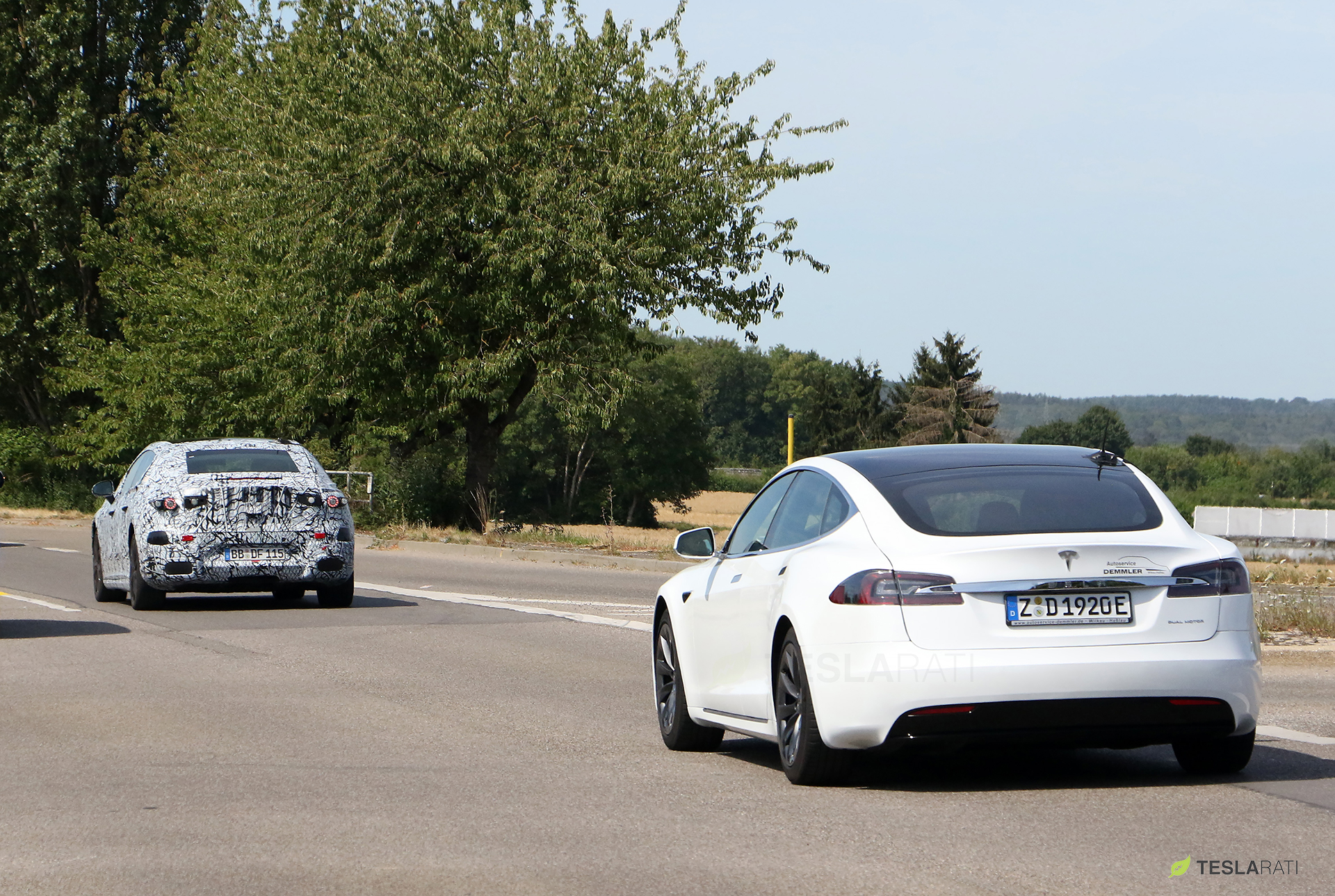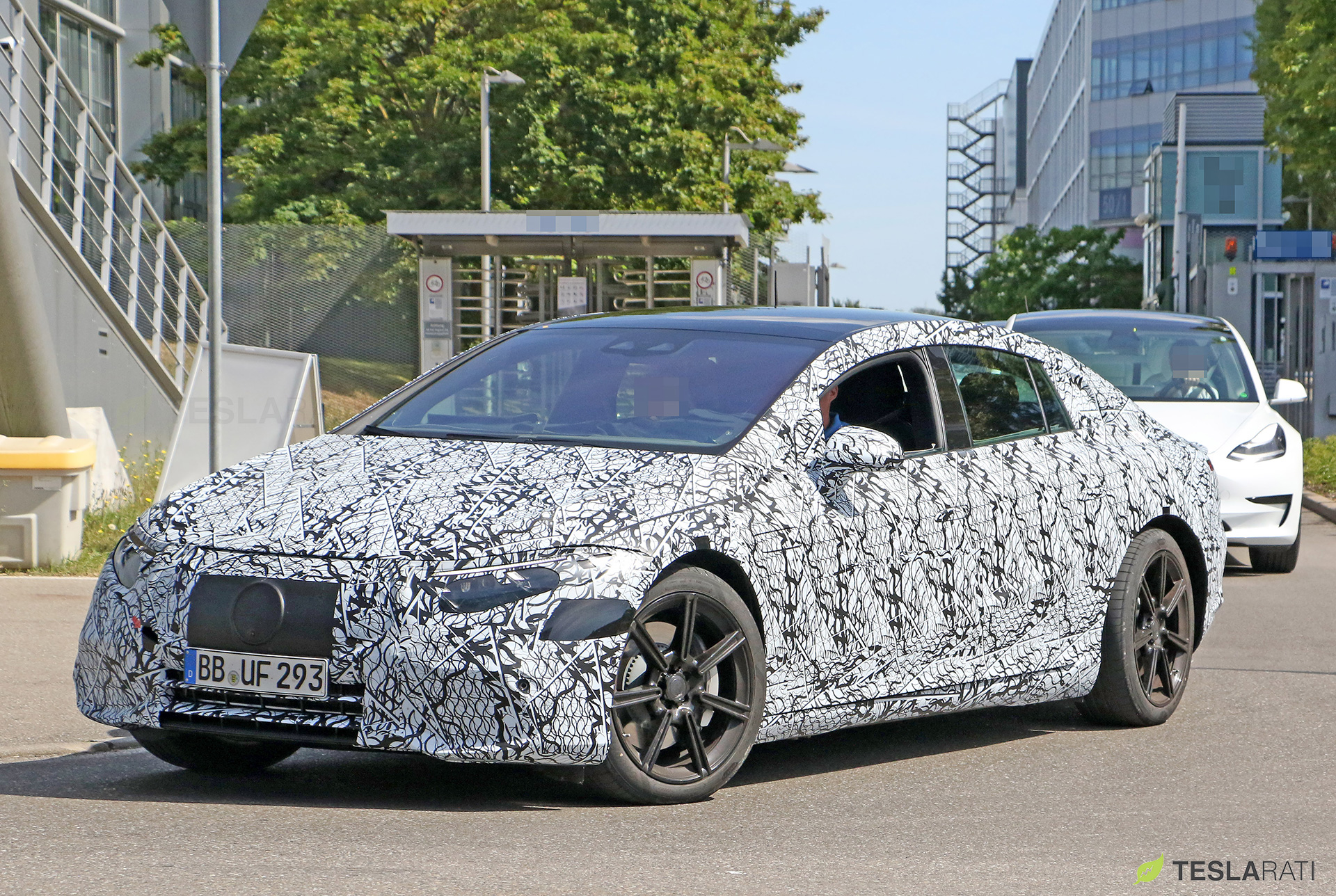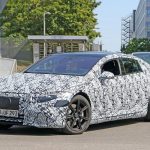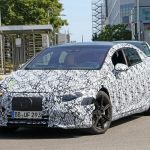

News
Mercedes EQS EV spied benchmarking against Tesla Model S and Model 3
Mercedes-Benz was spied testing its yet-to-be-released EQS long-range electric vehicle against Tesla’s flagship Model S, a vehicle that has arguably become the gold standard when it comes to the electric car to be benchmarked against.
Outfitted with a familiar camouflage wrap to conceal some of its exterior features, the EQS was spotted with a Tesla Model 3 and Model S in tow at the Mercedes Research and Development Center in Sindelfingen, Germany. The test facility is located outside of Stuttgart, where both Mercedes and Porsche are headquartered.
The Model 3 that arrived at the testing facility was not a Performance variant, as determined by the wheels, ride height, and trim of the vehicle. Tesla’s flagship sedan, the Model S, was also benchmarked against by Mercedes during the EQS testing session.

Design and Aesthetics
The EQS seen in the pictures appears to have wide and bulky body dimensions that are reminiscent of the Model S Plaid variant. Tesla’s Plaid Mode Model S was designed with a broader body and three separate motors for increased performance. Still, it also contained a rear diffuser for efficient air displacement and a rear spoiler that improved the aerodynamics of the vehicle.
The EQS in the photographs does not contain either a diffuser or a rear spoiler.
While somewhat reminiscent of other Mercedes-Benz models, the EQS’ rounded edges on the quarter panels give it a sportier look than the 2021 S-Class 450 SE, which is much more squared off at the corners of the vehicle.
Mercedes also says that the EQS will have digital headlamps and an all-digital front grille. A futuristic and fluid design will seamlessly integrate the body, dashboard, console, and armrests, and the luxury interior will be made from recycled materials to increase sustainability.

Performance and Other Features
Mercedes unveiled the EQS in 2019 and stated that two electric motors would give the car around 470 horsepower. The German automaker estimates that the EQS will reach 0-60 MPH in less than 4.5 seconds and that it will have 435 miles of all-electric range based on the more relaxed WLTP standard.
It will also pack a 100 kWh battery that will recharge from 0% to 80% in 20 minutes using high-power DC Fast Charging.
Mercedes also plans to use at least level 3 autonomy, but there is some indication that the German automaker may have to scrap these plans when the car is released. Mercedes and BMW had a joint partnership that was aimed toward developing self-driving technology, but it was frozen after a steep plunge in demand due to the COVID-19 pandemic.
The EQS is Mercedes’ first of its all-new line of electric cars. The German automaker is doing what many other car companies in the same country are attempting to do: breakthrough Tesla’s expansive lead in EV tech by developing impressive sustainable models.
The EQS starts at $96,000 and is expected to go on sale in 2021.
- Mercedes EQS testing against a Tesla Model S at the Research and Development Center in Sindelfingen, Germany (Teslarati)
- Mercedes EQS testing against a Tesla Model S at the Research and Development Center in Sindelfingen, Germany (Teslarati)
- Mercedes EQS testing against a Tesla Model S at the Research and Development Center in Sindelfingen, Germany (Teslarati)

News
Tesla starts showing how FSD will change lives in Europe
Local officials tested the system on narrow country roads and were impressed by FSD’s smooth, human-like driving, with some calling the service a game-changer for everyday life in areas that are far from urban centers.

Tesla has launched Europe’s first public shuttle service using Full Self-Driving (Supervised) in the rural Eifelkreis Bitburg-Prüm region of Germany, demonstrating how the technology can restore independence and mobility for people who struggle with limited transport options.
Local officials tested the system on narrow country roads and were impressed by FSD’s smooth, human-like driving, with some calling the service a game-changer for everyday life in areas that are far from urban centers.
Officials see real impact on rural residents
Arzfeld Mayor Johannes Kuhl and District Administrator Andreas Kruppert personally tested the Tesla shuttle service. This allowed them to see just how well FSD navigated winding lanes and rural roads confidently. Kruppert said, “Autonomous driving sounds like science fiction to many, but we simply see here that it works totally well in rural regions too.” Kuhl, for his part, also noted that FSD “feels like a very experienced driver.”
The pilot complements the area’s “Citizen Bus” program, which provides on-demand rides for elderly residents who can no longer drive themselves. Tesla Europe shared a video of a demonstration of the service, highlighting how FSD gives people their freedom back, even in places where public transport is not as prevalent.
What the Ministry for Economic Affairs and Transport says
Rhineland-Palatinate’s Minister Daniela Schmitt supported the project, praising the collaboration that made this “first of its kind in Europe” possible. As per the ministry, the rural rollout for the service shows FSD’s potential beyond major cities, and it delivers tangible benefits like grocery runs, doctor visits, and social connections for isolated residents.
“Reliable and flexible mobility is especially vital in rural areas. With the launch of a shuttle service using self-driving vehicles (FSD supervised) by Tesla in the Eifelkreis Bitburg-Prüm, an innovative pilot project is now getting underway that complements local community bus services. It is the first project of its kind in Europe.
“The result is a real gain for rural mobility: greater accessibility, more flexibility and tangible benefits for everyday life. A strong signal for innovation, cooperation and future-oriented mobility beyond urban centers,” the ministry wrote in a LinkedIn post.
News
Tesla China quietly posts Robotaxi-related job listing
Tesla China is currently seeking a Low Voltage Electrical Engineer to work on circuit board design for the company’s autonomous vehicles.

Tesla has posted a new job listing in Shanghai explicitly tied to its Robotaxi program, fueling speculation that the company is preparing to launch its dedicated autonomous ride-hailing service in China.
As noted in the listing, Tesla China is currently seeking a Low Voltage Electrical Engineer to work on circuit board design for the company’s autonomous vehicles.
Robotaxi-specific role
The listing, which was shared on social media platform X by industry watcher @tslaming, suggested that Tesla China is looking to fill the role urgently. The job listing itself specifically mentions that the person hired for the role will be working on the Low Voltage Hardware team, which would design the circuit boards that would serve as the nervous system of the Robotaxi.
Key tasks for the role, as indicated in the job listing, include collaboration with PCB layout, firmware, mechanical, program management, and validation teams, among other responsibilities. The role is based in Shanghai.
China Robotaxi launch
China represents a massive potential market for robotaxis, with its dense urban centers and supportive policies in select cities. Tesla has limited permission to roll out FSD in the country, though despite this, its vehicles have been hailed as among the best in the market when it comes to autonomous features. So far, at least, it appears that China supports Tesla’s FSD and Robotaxi rollout.
This was hinted at in November, when Tesla brought the Cybercab to the 8th China International Import Expo (CIIE) in Shanghai, marking the first time that the autonomous two-seater was brought to the Asia-Pacific region. The vehicle, despite not having a release date in China, received a significant amount of interest among the event’s attendees.
Elon Musk
Elon Musk and Tesla AI Director share insights after empty driver seat Robotaxi rides
The executives’ unoccupied tests hint at the rapid progress of Tesla’s unsupervised Robotaxi efforts.

Tesla CEO Elon Musk and AI Director Ashok Elluswamy celebrated Christmas Eve by sharing personal experiences with Robotaxi vehicles that had no safety monitor or occupant in the driver’s seat. Musk described the system’s “perfect driving” around Austin, while Elluswamy posted video from the back seat, calling it “an amazing experience.”
The executives’ unoccupied tests hint at the rapid progress of Tesla’s unsupervised Robotaxi efforts.
Elon and Ashok’s firsthand Robotaxi insights
Prior to Musk and the Tesla AI Director’s posts, sightings of unmanned Teslas navigating public roads were widely shared on social media. One such vehicle was spotted in Austin, Texas, which Elon Musk acknowleged by stating that “Testing is underway with no occupants in the car.”
Based on his Christmas Eve post, Musk seemed to have tested an unmanned Tesla himself. “A Tesla with no safety monitor in the car and me sitting in the passenger seat took me all around Austin on Sunday with perfect driving,” Musk wrote in his post.
Elluswamy responded with a 2-minute video showing himself in the rear of an unmanned Tesla. The video featured the vehicle’s empty front seats, as well as its smooth handling through real-world traffic. He captioned his video with the words, “It’s an amazing experience!”
Towards Unsupervised operations
During an xAI Hackathon earlier this month, Elon Musk mentioned that Tesla owed be removing Safety Monitors from its Robotaxis in Austin in just three weeks. “Unsupervised is pretty much solved at this point. So there will be Tesla Robotaxis operating in Austin with no one in them. Not even anyone in the passenger seat in about three weeks,” he said. Musk echoed similar estimates at the 2025 Annual Shareholder Meeting and the Q3 2025 earnings call.
Considering the insights that were posted Musk and Elluswamy, it does appear that Tesla is working hard towards operating its Robotaxis with no safety monitors. This is quite impressive considering that the service was launched just earlier this year.











